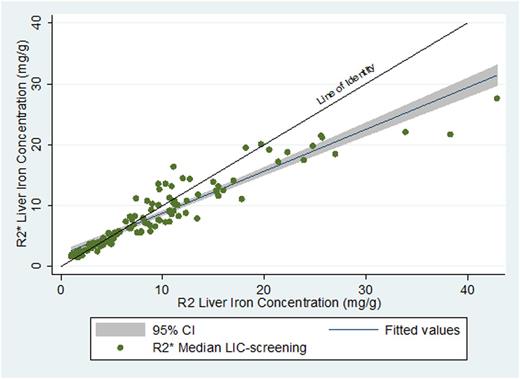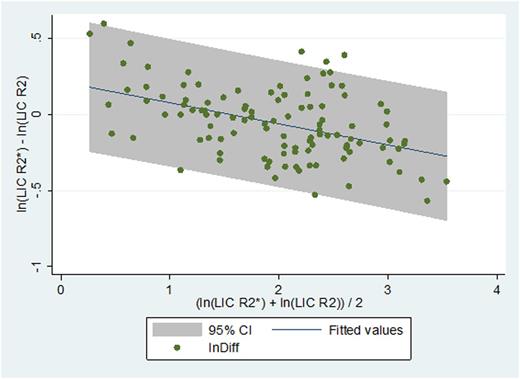Abstract
Chronic transfusion therapy represents the standard of care for sickle cell anemia (SCA) patients with abnormal transcranial Doppler (TCD) ultrasound or prior stroke. While effective, monthly transfusions produce iron overload and toxicity if not controlled with chelation therapies. Liver iron concentration (LIC) is a powerful surrogate for total body iron stores. Unfortunately, liver biopsy is not suited for longitudinal analysis because it is invasive, expensive, and prone to sampling variability. MRI transverse relaxation rates, R2 and R2*, are highly correlated with LIC and have mostly supplanted liver biopsy for iron quantification in clinical practice and clinical trials. Since R2 and R2* have different sensitivity to the size and scale of tissue iron distribution, we compared the agreement of LIC values predicted by R2 and R2* in children with SCA and transfusional iron overload from the prospective multicenter TCD with Transfusions Changing to Hydroxyurea (TWiTCH) trial (ClinicalTrials.gov; NCT01425307).
133 patients underwent LIC assessment using both R2 and R2* techniques at 22 MRI sites. All sites used 1.5 Tesla magnets and torso phased array coils. Images for R2 measurements were collected on validated scanners and analyzed centrally according to the FerriScan” protocol (Resonance Health, Western Australia, see St Pierre, T.G., et al. Blood,105, 855-861, 2005). Images for R2* assessment were collected using multiple-echo gradient echo sequences (see Wood, J.C., et al. Blood,106, 1460-1465, 2005). Images were analyzed centrally at Children's Hospital Los Angeles, using an exponential-plus-constant fit to the signal decay. Bland-Altman analysis on log-transformed LIC values was used to test agreement between LICR2 and LICR2*; the residuals of this relationship were probed for association with transfusion/chelation history, markers of inflammation, and markers of hemolysis.
(A) LICR2* versus LICR2 with best fit regression line and line of identity. (B) Bland Altman plot with 95% limits of agreement between log(LICR2*) and log(LICR2).
(A) LICR2* versus LICR2 with best fit regression line and line of identity. (B) Bland Altman plot with 95% limits of agreement between log(LICR2*) and log(LICR2).
Figure 1A illustrates the scattergram between LICR2* and LICR2. The variance of the disagreement between the two techniques increases with LIC, so log-transformation was performed prior to Bland Altman analysis. LICR2* was systematically higher than LICR2 below about 5 mg Fe/g dw and systematically lower above 5 mg Fe/g dw. Bland Altman comparison of the log-transformed data (Figure 1B) reveals a downward trend (r2 of 0.203, p<0.0001). After correcting for the trend, 95% limits of agreement were -0.42 to 0.42, translating to 95% limits of agreement of the ratio of the two LIC measurements of 0.66 to 1.52. After controlling for mean log LIC, differences in log LIC values were not associated with transfusion or chelation history, markers of inflammation, or markers of hemolysis.
Systematic bias is present between LICR2 and LICR2* in a cohort of children with SCA and transfusional iron overload. Even after correcting these differences, LICR2 and LICR2* also demonstrate significant intrasubject variability, comparable to the error both techniques displayed with respect to biopsy, precluding use of these metrics interchangeably. This implies that LICR2 and LICR2* have potentially clinically significant deviations from true LIC. Rather than sampling or MRI measurement errors, which are consistently < 10% in multiple studies, these disparities likely reflect calibration bias introduced by intersubject differences in tissue iron distribution. Longitudinal LIC determination should lessen their impact, however, and the changes in LIC predicted by R2 and R2* will be compared using one and two year data from the TWiTCH trial.
Wood:Novartis: Honoraria; Apopharma: Honoraria, Patents & Royalties; Shire: Consultancy, Research Funding. Off Label Use: Hydroxyurea is FDA-approved for use in adults but not children. Kwiatkowski:Shire: Consultancy; Resonance Health: Research Funding. St. Pierre:Resonance Health Ltd: Consultancy, Equity Ownership, Membership on an entity’s Board of Directors or advisory committees, Speakers Bureau; Novartis: Honoraria, Membership on an entity’s Board of Directors or advisory committees, Research Funding, Speakers Bureau.
Author notes
Asterisk with author names denotes non-ASH members.



